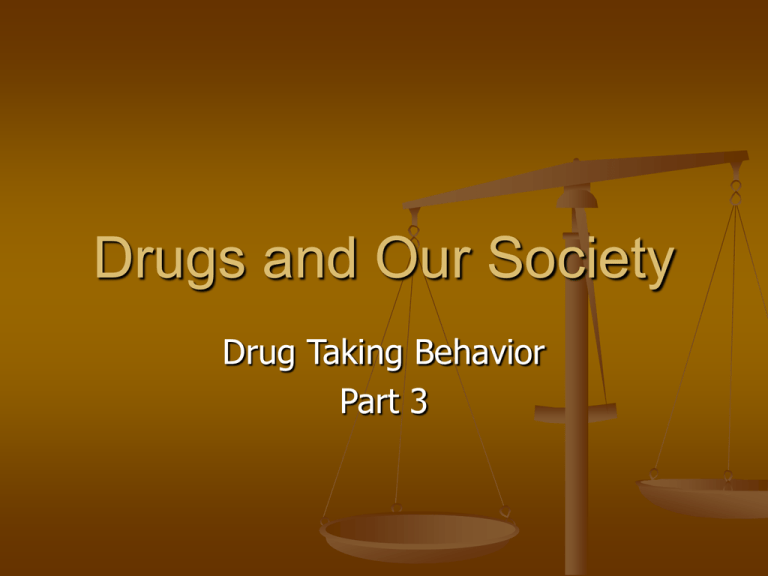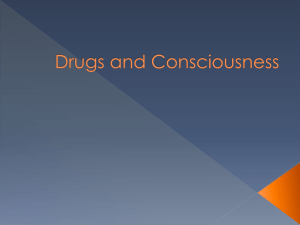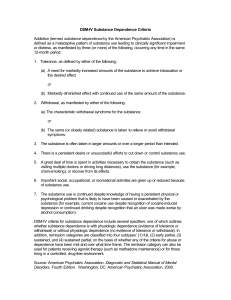Drugs and Our Society Drug Taking Behavior Part 3
advertisement

Drugs and Our Society Drug Taking Behavior Part 3 Drug Dependence and Toxicity 1. 2. 3. No other word in the field of drug research causes more misunderstanding or has been abused more than the term “dependence” The American Psychiatric Association uses the term ‘substance’ because of this confusion - they use ‘substance abuse’ and ‘substance misuse’ Drug toxicity is the physical or psychological harm a drug might present to the user - acute toxicity refers to the harm that is immediate, soon after the drug is taken Dependence and Toxicity, cont. 4. 5. 6. Describing dosages - dose refers to the quantity of a drug taken into the body - it is usually measured in milligrams (or micrograms) A milligram is 1/1000th of a gram - there are a little over 28 grams per ounce The effect of the drug is related to its concentration in the body rather than the absolute amount administered Dependency and Toxicity, cont. 7. 8. 9. The same amount of drug given to persons of different sizes will reach different concentrations in the body To insure drug presence in the same concentrations in the brain, different doses are given according to body weight They are usually reported in terms of milligrams (mg) per kilograms (kg) of body weight - 6.5 mg per kg (kilogram = 2.2 pounds) - 220 lb person gets 650 mg / 110 lb person gets 325 mg Dependence and Toxicity, cont 10. 11. 12. Drug toxicity impacts both licit and illicit drugs - the book shows the dose-response curve - S-shaped graph to show toxicity of a drug Effective dose (ED) - shows effectiveness on a certain percent of drug-taking group - ED50: effective on 50% of those using that drug Lethal dose (LD) - shows % of lethal drug dose for that group Dependence and Toxicity, cont 13. 14. 15. - LD99: lethal for 99% - individual batch of heroin, meth, etc. ED response curve (S) - 0 to 100: shows effectiveness (how much taken) LD response curve (S) - 0 to 100: shows lethal dose (how much taken) 50/50 ED-LD is called the therapeutic index - margin of safety means higher ratio - safer / less toxic Drug Dependence and Tolerance 1. 2. The term dependence is generally used in two ways - first, a state in which discontinuation causes withdrawal symptoms - secondly, where a person compulsively takes a drug Physical dependence - our body needs the drug to continue functioning - to avoid the pain of withdrawal Dependence and Tolerance, cont 3. 4. The actual symptoms vary according to the drug being withdrawn - some have no physical dependence at all - such as marijuana - the body builds a “tolerance” to the ingested drug Tolerance - “A state of progressively decreasing responsiveness to a drug” - as tolerance develops, increasing amounts of the drug is required Dependence and Tolerance, cont 5. 6. Pharmacological tolerance - body adjusts/compensates for presence of a particular drug - to achieve desired effect, increase amount or frequency Behavioral tolerance - individual learns to adjust to the presence of drugs - normal surroundings / settings for drug use - new people / new location / greater high Dependence and Tolerance, cont 7. 8. Cross-tolerance - gives one tolerance to chemically similar drugs - LSD: tolerance to other hallucinogens Reverse tolerance - user will feel effects from lesser amounts of the drug - drug stored in the fatty tissue which later breaks down - LSD users who feel effects weeks / months later after having stopped its use Psychological Dependence 1. 2. 3. A person will compulsively use drugs that do not cause unpleasant withdrawal symptoms - also referred to as ‘psychic addiction’ This is a belief by the user that they cannot function without the drug - they have developed a psychological craving - they desire the pleasurable drug effects They have a fear of doing something without taking the drug - speaking before a large group of people - meeting members of the opposite sex Drugs, Violence, and Crime 1. 2. Studies show that the majority of those arrested for personal and property crimes had ingested or were under the influence of drugs at the time - we do associate violence with drugs and we have several types of drug induced violence Pharmacological violence - violent acts committed while under the influence of a particular psychoactive drug - this type of violence suggests that the drug caused the violence Drugs, Violence, and Crime, cont 3. 4. - certain drugs cause individuals to become suspicious / irritable / to lash out at people - alcohol / crack cocaine / methamphetamine Economically Compulsive Violence - the use of violence to finance use of drugs Systemic Violence - violence used in establishing territory for drug sales - gang violence - organized crime violence Drugs and the Law 1. 2. Whiskey Rebellion (1791) - federal government placed an excise tax on whiskey - farmers in southwest Pennsylvania violently objected - Washington sent in the militia It was important because: - it produced income for federal government - it also showed that the government had the power to enforce federal laws in the states Drugs and the Law, cont 3. 4. Pure Food and Drug Act (1906) - patent medicines were unregulated - 1890 to 1906: golden age of patent meds - President Theodore Roosevelt established the Food and Drug Administration (FDA) Harrison Act (1914) - began to control narcotics / opiates - prescriptions were required to obtain - narcotics could not be bought over-thecounter - believed to be a racist act aimed at Chinese Drugs and the Law, cont 5. 6. Marijuana Tax Act (1937) - believed it was also a racist act aimed at Mexican immigrants - federal government placed a large tax on growing / transporting / selling Food, Drug, and Cosmetic Act (1938) - pharmaceutical companies needed to be controlled - turn out drugs they said were helpful - people were dying from these drugs Drugs and the Law, cont 7. - 1906 act protected drug companies from lawsuits FDA allowed to place drugs into 3 categories - Category I: drugs determined to be safe, effective, and properly labeled - Category II: those not generally recognized as safe or effective, or mislabeled, and must be withdrawn within 6 months - Category III: those for which data are insufficient to determine general recognition of safety and effectiveness Drugs and the Law, cont 8. 9. Comprehensive Drug Abuse Prevention and Control Act of 1970 - Uniformed Controlled Substances Act (VUCSA) - placed drugs in 5 schedules to control manufacturers / distributors / and users Anti-Drug Act (1988) - emphasized stringent punishment of users - punishment could be waived by treatment - drug czar / zero tolerance / registration




